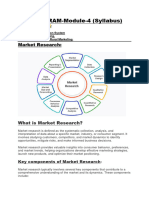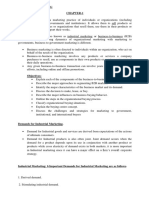0 ratings0% found this document useful (0 votes)
10 viewsCB Objectives
CB Objectives
Uploaded by
gkj999Copyright:
© All Rights Reserved
Available Formats
Download as PDF, TXT or read online from Scribd
CB Objectives
CB Objectives
Uploaded by
gkj9990 ratings0% found this document useful (0 votes)
10 views7 pagesOriginal Title
CB objectives
Copyright
© © All Rights Reserved
Available Formats
PDF, TXT or read online from Scribd
Share this document
Did you find this document useful?
Is this content inappropriate?
Copyright:
© All Rights Reserved
Available Formats
Download as PDF, TXT or read online from Scribd
Download as pdf or txt
0 ratings0% found this document useful (0 votes)
10 views7 pagesCB Objectives
CB Objectives
Uploaded by
gkj999Copyright:
© All Rights Reserved
Available Formats
Download as PDF, TXT or read online from Scribd
Download as pdf or txt
You are on page 1of 7
What is Consumer
Behaviour? Objectives,
Importance, and Models
Comprehending consumer needs:
Businesses utilize consumer behaviour research to gain
valuable insights into the needs, desires, and motivations
of their target audience. Consequently, understanding
empowers companies to create products and services
that successfully cater to consumer demands, resulting in
enhanced customer satisfaction.
Fabricating effective marketing strategies:
Leveraging the study, businesses can discern the most
efficient marketing techniques and channels to reach their
target audience. Furthermore, this knowledge aids in the
development of targeted and compelling advertising
campaigns, pricing strategies, and promotional activities
that connect with consumers and boost sales.
Identifying market opportunities:
By conducting consumer behaviour research, businesses
can detect emerging trends, evolving preferences, and
untapped market needs. Thereby enabling companies to
spot new opportunities for products or services, enhance
existing offerings, and maintain a competitive edge in the
market.
Enhancing customer experience:
Through this study, companies can acquire valuable
insights into the complete customer journey,
encompassing the stages from pre-purchase to post-
purchase. This understanding empowers businesses to
enhance the customer experience, personalize
interactions, and deliver exceptional service. As a result,
this fosters customer loyalty and generates positive word-
of-mouth.
Minimizing risks and failures:
Understanding consumer behaviour helps businesses
minimize risks associated with product failures or
unsuccessful marketing campaigns. Through the analysis
of consumer preferences, feedback, and behaviour,
companies can make informed decisions concerning
product design, features, packaging, and marketing
strategies, consequently minimizing the likelihood of
failure.
Building strong brand relationships:
The research assists in establishing robust, long-term
relationships with customers. Through understanding
consumer preferences, values, and purchasing
behaviours, companies can customize their brand
messaging, communication, and offerings, enabling them
to forge a powerful emotional bond with consumers.
Define objectives:
Clearly articulate the goals and objectives of the customer
insight strategy by identifying the specific insights you
aim to gather and how they will bolster your business
objectives.
Identify data collection sources:
Identify the sources of customer data that will yield
valuable insights like customer surveys, focus groups,
interviews, social media listening, website analytics, sales
data, customer service interactions, and market research
reports.
Gather and analyze data:
Implement strategies to gather pertinent data from the
identified sources by employing methods such as
deploying surveys, conducting interviews, or analyzing
existing data sets. Also, employ suitable data analysis
techniques to unveil patterns, trends, and correlations
within the data.
Segmentation and profiling:
Segment your customer base according to shared
characteristics, such as demographics, psychographics,
purchasing behaviour, or preferences. Simultaneously,
develop customer profiles or personas to gain a deeper
understanding of distinct customer segments.
Conduct qualitative study:
Conduct qualitative research methods like focus groups
or in-depth interviews to gather deeper insights into
customer motivations, needs, and perceptions. This can
further provide valuable qualitative insights to
complement quantitative analysis.
Customer journey mapping:
Map out the customer journey and identify key
touchpoints and interactions where insights can be
gathered. This helps in understanding customer behaviour
at different stages and identifying areas for improvement.
Collaborate cross-functionally:
Engage cross-functional teams from departments like
marketing, product development, sales, and customer
service to collaborate and share insights. Align strategies
to ensure effective implementation of the customer
insight strategy across the organization.
Apply insights:
Utilize the acquired insights to guide decision-making and
develop strategies. It’s important to customise product
offerings, marketing campaigns, and customer
experiences according to identified customer preferences
and needs.
Continuously iterate and refine:
Continuously gather data, analyse it, and update your
understanding of consumer behaviour. Also, regularly
review and refine your customer insight strategy to ensure
it remains aligned with changing market dynamics and
consumer preferences.
Ethical considerations:
Ensure data collection and analysis processes adhere to
ethical guidelines and privacy regulations. Also, safeguard
customer data responsibly to uphold trust and
confidentiality.
You might also like
- Stories at Work - Unlock The Secret To Business StorytellingDocument194 pagesStories at Work - Unlock The Secret To Business Storytellingankitayadav3412No ratings yet
- Dani Martinez: Work ExperienceDocument1 pageDani Martinez: Work ExperienceNoura GamalNo ratings yet
- Athlete Sponsorship GuideDocument19 pagesAthlete Sponsorship GuidestevennjohnsonNo ratings yet
- The Internal Factor Evaluation IFE MatriDocument4 pagesThe Internal Factor Evaluation IFE MatridominicNo ratings yet
- Absolut Vodka Case Study Nida BarrosDocument4 pagesAbsolut Vodka Case Study Nida BarrosNida BarrosNo ratings yet
- Case Study DiversificationDocument10 pagesCase Study DiversificationSebinKJosephNo ratings yet
- Customer OrientationDocument3 pagesCustomer Orientationzanibsuleman4343No ratings yet
- What Is Strategic Sales ManagementDocument6 pagesWhat Is Strategic Sales ManagementkarthikNo ratings yet
- Introduction - 1 .Document8 pagesIntroduction - 1 .Greeshma AlwalNo ratings yet
- Group 3Document4 pagesGroup 3Ishan MaheshwariNo ratings yet
- SMM Complete NotesDocument90 pagesSMM Complete NotesOM ChaudhariNo ratings yet
- Explain in Details The Concept of Marketing Mix PDFDocument4 pagesExplain in Details The Concept of Marketing Mix PDFVincent ChilesheNo ratings yet
- Unit - 2 NotesDocument10 pagesUnit - 2 NotesprofsureshkkumarNo ratings yet
- CLC - Analytics Problem StatementDocument13 pagesCLC - Analytics Problem StatementRana UsamaNo ratings yet
- Chubb Business Capabilities v2 - FINALDocument12 pagesChubb Business Capabilities v2 - FINALRoberto EnriqueNo ratings yet
- BDE StrategyDocument2 pagesBDE StrategyPG FIQNo ratings yet
- Identify You-WPS OfficeDocument2 pagesIdentify You-WPS OfficebashiratNo ratings yet
- MBA Marketing Management Topics Thursday June6 2024Document10 pagesMBA Marketing Management Topics Thursday June6 2024kebejik384No ratings yet
- Introduction to MarketingDocument14 pagesIntroduction to Marketingmimawi9161No ratings yet
- Consumer Behavior Is A Branch of Marketing and Psychology THDocument23 pagesConsumer Behavior Is A Branch of Marketing and Psychology THnarutoasami2No ratings yet
- Haramaya UniversityDocument7 pagesHaramaya UniversityibsaashekaNo ratings yet
- Marketing ManagementDocument6 pagesMarketing ManagementBae BaeNo ratings yet
- Marketing Decision MakingDocument5 pagesMarketing Decision MakingeagonzalesdetorresNo ratings yet
- MarketingDocument18 pagesMarketingYds DsNo ratings yet
- The Marketing Process2Document3 pagesThe Marketing Process2ak2511803No ratings yet
- CH 3Document68 pagesCH 3Nibras Uddin NibirNo ratings yet
- Answer AssssDocument20 pagesAnswer Assssalexsabebe28No ratings yet
- Customer AnalysisDocument9 pagesCustomer AnalysismbolaNo ratings yet
- Dmkt302 Consumer BehaviourDocument11 pagesDmkt302 Consumer BehaviourclintongcrNo ratings yet
- What Is Marketing (Autosaved) 2Document5 pagesWhat Is Marketing (Autosaved) 2libnittoNo ratings yet
- Analyzing Customer Expectations and PreferencesDocument6 pagesAnalyzing Customer Expectations and Preferenceskhandelwal2121No ratings yet
- Application of Marketing ResearchDocument22 pagesApplication of Marketing ResearchVanisha SinghNo ratings yet
- Marketing Research (Cruz, Jhazmine)Document4 pagesMarketing Research (Cruz, Jhazmine)cruzjhazminetrinidadNo ratings yet
- Lowersixth WorkDocument20 pagesLowersixth WorkkinjangmeritbihNo ratings yet
- 3rd ModuleDocument33 pages3rd ModuleRyan Paul BilgeraNo ratings yet
- Unit V-3Document47 pagesUnit V-3prashansa.yadav.1274No ratings yet
- CB NewDocument15 pagesCB NewabumehebulNo ratings yet
- Principles of Marketing Unit 6Document10 pagesPrinciples of Marketing Unit 6DIPANSHU PRASADNo ratings yet
- Market ResearchDocument2 pagesMarket ResearchsaineeshNo ratings yet
- Kidist AssginmentDocument14 pagesKidist Assginmentalexsabebe28No ratings yet
- Designing Marketing Programs To Build Brand Equity: Esha DewanDocument45 pagesDesigning Marketing Programs To Build Brand Equity: Esha DewanEsha DewanNo ratings yet
- Customer Analysis & Insight: An Introductory Guide To Understanding Your AudienceFrom EverandCustomer Analysis & Insight: An Introductory Guide To Understanding Your AudienceNo ratings yet
- VIVADocument86 pagesVIVAUnni KuttanNo ratings yet
- Marketing Answers 90Document26 pagesMarketing Answers 90yygvyhdsbsNo ratings yet
- Kalid's Assignment FinalDocument9 pagesKalid's Assignment FinalibsaashekaNo ratings yet
- Consumer Behaviour Chapter 1Document26 pagesConsumer Behaviour Chapter 1MITHRA S S PSGRKCWNo ratings yet
- Consumer Behaviour U - 1, L - 2Document55 pagesConsumer Behaviour U - 1, L - 2Karthick JayaramanNo ratings yet
- Final Project HDocument9 pagesFinal Project Hsyed Haider AliNo ratings yet
- Explaination On The PresentationDocument7 pagesExplaination On The PresentationwbjueraNo ratings yet
- Answer To Some Exam 3Document2 pagesAnswer To Some Exam 3Moon GusionNo ratings yet
- tài liệu ôn cuối kìDocument90 pagestài liệu ôn cuối kìtrannguyenan0126No ratings yet
- Relationship Marketing in Retailing & International RetailingDocument72 pagesRelationship Marketing in Retailing & International Retailingkiran 17mba11No ratings yet
- IED RAM Module 4Document17 pagesIED RAM Module 4Jagyandutta NaikNo ratings yet
- Marketing Management AllDocument45 pagesMarketing Management Allkomall.menaria99No ratings yet
- Marketing Management NotesDocument4 pagesMarketing Management NotesKeerthana RameshNo ratings yet
- Scope and Importance of ManagementDocument22 pagesScope and Importance of Managementvenkateshchinnu11No ratings yet
- Class 1Document5 pagesClass 1tajnaharpNo ratings yet
- Marketing 2Document2 pagesMarketing 2davweezidNo ratings yet
- HARMEEDocument8 pagesHARMEEibsaashekaNo ratings yet
- ch11 Part 2 Customer-Driven MarketingDocument14 pagesch11 Part 2 Customer-Driven MarketingWatiq KhanNo ratings yet
- Sales and Marketing-GptDocument40 pagesSales and Marketing-Gptdouglasocharo725No ratings yet
- Characteristics of Good Marketing ResearchDocument18 pagesCharacteristics of Good Marketing Researchsln5No ratings yet
- UNIT-4 Digital MarketingDocument17 pagesUNIT-4 Digital Marketingbajpaikomal.55No ratings yet
- Unit 5 NVPDocument2 pagesUnit 5 NVPishjotsinghbhatiaNo ratings yet
- Cephas Thesis FinalDocument53 pagesCephas Thesis FinalEze Ukaegbu100% (1)
- Meraki Company Business PlanDocument20 pagesMeraki Company Business PlanJuniel RagadioNo ratings yet
- Question 1: What Is The Value of ABC Bakery? How About The Bakery Industry in Viet Nam? (Market, Competitor, Consumer Trends)Document5 pagesQuestion 1: What Is The Value of ABC Bakery? How About The Bakery Industry in Viet Nam? (Market, Competitor, Consumer Trends)Phương ThảoNo ratings yet
- MaybellineDocument9 pagesMaybellineJeffisa D 꼬사시100% (1)
- Consumer Behavior Final ProposalDocument9 pagesConsumer Behavior Final Proposalinsane_artistNo ratings yet
- Apple's Branding StrategyDocument7 pagesApple's Branding StrategyJoyce Wang100% (2)
- SEA - Shoppertainment 2024 - The Future of Consumer & CommerceDocument35 pagesSEA - Shoppertainment 2024 - The Future of Consumer & CommerceRizqi SkyLabsNo ratings yet
- Study On Customer Preference and Satisfaction Towards Prismatic Technologies, PatialaDocument14 pagesStudy On Customer Preference and Satisfaction Towards Prismatic Technologies, Patialajagseer singh0% (1)
- Brand Report CardDocument4 pagesBrand Report CardjagadishprasadNo ratings yet
- PHD THESIS + Addendum + SynopsisDocument342 pagesPHD THESIS + Addendum + SynopsisPrithivi RajNo ratings yet
- Hunter Fenollol ResumeDocument2 pagesHunter Fenollol ResumeAnonymous DHEh9TVbnNo ratings yet
- Chapter 4 5Document34 pagesChapter 4 5Vanessa SisonNo ratings yet
- Bimtech Case Questions+ Project Details Phase 1+2Document5 pagesBimtech Case Questions+ Project Details Phase 1+2RetailNo ratings yet
- Meena Malche MBA 04Document30 pagesMeena Malche MBA 04Meena MalcheNo ratings yet
- (EXT) Oct TikTok Shop Solid Lah! & 11.11Document29 pages(EXT) Oct TikTok Shop Solid Lah! & 11.11Kate NguyenNo ratings yet
- JournalDocument354 pagesJournalJai YadavNo ratings yet
- Agora - Managing Supply ChainDocument25 pagesAgora - Managing Supply Chainabid746No ratings yet
- Alcohol Purchasing DecisionsDocument29 pagesAlcohol Purchasing DecisionsDiana KilelNo ratings yet
- Google Ads StrategyDocument4 pagesGoogle Ads StrategyApoorvNo ratings yet
- Choco-Vim Initial ResearchDocument3 pagesChoco-Vim Initial ResearchChantal Chan0% (2)
- Article Employee Retention Practices in Hospitality Industry in Nepal SthapitDocument22 pagesArticle Employee Retention Practices in Hospitality Industry in Nepal SthapitSajesh SinghNo ratings yet
- Consumer PerceptionDocument29 pagesConsumer PerceptionSaif Ul HaqNo ratings yet
- Business Marketing-2 PDFDocument135 pagesBusiness Marketing-2 PDFShrinivasa NNo ratings yet
- AnswersDocument9 pagesAnswersRanaNo ratings yet

























































































